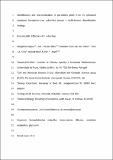Files in this item
Identification and characterization of parasitism genes from the pinewood nematode Bursaphelenchus xylophilus reveals a multilayered detoxification strategy
Item metadata
| dc.contributor.author | Espada, Margarida | |
| dc.contributor.author | Silva, Ana Cláudia | |
| dc.contributor.author | Eves van den Akker, Sebastian | |
| dc.contributor.author | Cock, Peter J. A. | |
| dc.contributor.author | Mota, Manuel | |
| dc.contributor.author | Jones, John T. | |
| dc.date.accessioned | 2016-06-15T23:33:02Z | |
| dc.date.available | 2016-06-15T23:33:02Z | |
| dc.date.issued | 2016-02-01 | |
| dc.identifier | 241082620 | |
| dc.identifier | 46fa6d93-85ff-4085-a870-14954be84cf1 | |
| dc.identifier | 84956575961 | |
| dc.identifier | 000368704300013 | |
| dc.identifier.citation | Espada , M , Silva , A C , Eves van den Akker , S , Cock , P J A , Mota , M & Jones , J T 2016 , ' Identification and characterization of parasitism genes from the pinewood nematode Bursaphelenchus xylophilus reveals a multilayered detoxification strategy ' , Molecular Plant Pathology , vol. 17 , no. 2 , pp. 286-295 . https://doi.org/10.1111/mpp.12280 | en |
| dc.identifier.issn | 1464-6722 | |
| dc.identifier.uri | https://hdl.handle.net/10023/8996 | |
| dc.description | This work was supported by the REPHRAME project (KBBE.2010.1.4-09). ME is funded by FCT (Fundação para a Ciência e a Tecnologia, IP) under a PhD grant (SFRH/BD/84541/2012). ME and MM are also funded by FEDER Funds through the Operational Programme for Competitiveness Factors—COMPETE and National Funds through FCT—Foundation for Science and Technology under the Strategic Projects PEst-C/AGR/UI0115/2011 and PEst-OE/AGR/UI0115/2014. AS was funded by an ERASMUS MUNDUS Category B scholarship awarded through project 2008–2102 (EUMAINE). The James Hutton Institute receives funding from the Scottish Government Rural and Environmental Science and Analytical Services division (RESAS). | en |
| dc.description.abstract | The migratory endoparasitic nematode Bursaphelenchus xylophilus, which is the causal agent of pine wilt disease, has phytophagous and mycetophagous phases during its life cycle. This highly unusual feature distinguishes it from other plant-parasitic nematodes and requires profound changes in biology between modes. During the phytophagous stage, the nematode migrates within pine trees, feeding on the contents of parenchymal cells. Like other plant pathogens, B.xylophilus secretes effectors from pharyngeal gland cells into the host during infection. We provide the first description of changes in the morphology of these gland cells between juvenile and adult life stages. Using a comparative transcriptomics approach and an effector identification pipeline, we identify numerous novel parasitism genes which may be important for the mediation of interactions of B.xylophilus with its host. In-depth characterization of all parasitism genes using in situ hybridization reveals two major categories of detoxification proteins, those specifically expressed in either the pharyngeal gland cells or the digestive system. These data suggest that B.xylophilus incorporates effectors in a multilayer detoxification strategy in order to protect itself from host defence responses during phytophagy. | |
| dc.format.extent | 10 | |
| dc.format.extent | 2793081 | |
| dc.language.iso | eng | |
| dc.relation.ispartof | Molecular Plant Pathology | en |
| dc.subject | Bursaphelenchus xylophilus | en |
| dc.subject | Effectors | en |
| dc.subject | Gland cells | en |
| dc.subject | Transcriptome | en |
| dc.subject | Xenobiotic metabolism | en |
| dc.subject | QH301 Biology | en |
| dc.subject | Plant Science | en |
| dc.subject | Agronomy and Crop Science | en |
| dc.subject | Soil Science | en |
| dc.subject | Molecular Biology | en |
| dc.subject | NDAS | en |
| dc.subject.lcc | QH301 | en |
| dc.title | Identification and characterization of parasitism genes from the pinewood nematode Bursaphelenchus xylophilus reveals a multilayered detoxification strategy | en |
| dc.type | Journal article | en |
| dc.contributor.institution | University of St Andrews. School of Biology | en |
| dc.contributor.institution | University of St Andrews. Biomedical Sciences Research Complex | en |
| dc.identifier.doi | https://doi.org/10.1111/mpp.12280 | |
| dc.description.status | Peer reviewed | en |
| dc.date.embargoedUntil | 2016-06-16 |
This item appears in the following Collection(s)
Items in the St Andrews Research Repository are protected by copyright, with all rights reserved, unless otherwise indicated.

